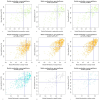Analysis of the Differences Among Camellia oleifera Grafting Combinations in Its Healing Process
- PMID: 40805781
- PMCID: PMC12349247
- DOI: 10.3390/plants14152432
Analysis of the Differences Among Camellia oleifera Grafting Combinations in Its Healing Process
Abstract
Grafting serves as a crucial propagation technique for superior Camellia oleifera varieties, where rootstock-scion compatibility significantly determines survival and growth performance. To systematically evaluate grafting compatibility in this economically important woody oil crop, we examined 15 rootstock-scion combinations using 'Xianglin 210' as the scion, assessing growth traits and conducting physiological assays (enzymatic activities of SOD and POD and levels of ROS and IAA) at multiple timepoints (0-32 days post-grafting). The results demonstrated that Comb. 4 (Xianglin 27 rootstock) exhibited superior compatibility, characterized by systemic antioxidant activation (peaking at 4-8 DPG), rapid auxin accumulation (4 DPG), and efficient sugar allocation. Transcriptome sequencing and WGCNA analysis identified 3781 differentially expressed genes, with notable enrichment in stress response pathways (Hsp70, DnaJ) and auxin biosynthesis (YUCCA), while also revealing key hub genes (FKBP19) associated with graft-healing efficiency. These findings establish that successful grafting in C. oleifera depends on coordinated rapid redox regulation, auxin-mediated cell proliferation, and metabolic reprogramming, with Comb. 4 emerging as the optimal rootstock choice. The identified molecular markers not only advance our understanding of grafting mechanisms in woody plants but also provide valuable targets for future breeding programs aimed at improving grafting success rates in this important oil crop.
Keywords: Camellia oleifera; antioxidant enzymes; auxin; grafting compatibility; transcriptomics.
Conflict of interest statement
The authors declare no conflicts of interest.
Figures








Similar articles
-
Drought Resistance Evaluation of Camellia oleifera var. "Xianglin 210" Grafted onto Different Rootstocks.Plants (Basel). 2025 Aug 18;14(16):2568. doi: 10.3390/plants14162568. Plants (Basel). 2025. PMID: 40872191
-
Transcriptional dynamics reveals the asymmetrical events underlying graft union formation in pecan (Carya illinoinensis).Tree Physiol. 2024 May 5;44(5):tpae040. doi: 10.1093/treephys/tpae040. Tree Physiol. 2024. PMID: 38598328
-
Transcriptome dynamics reveals how asymmetric expression of genes promotes graft healing in Sapindus mukorossi.Plant Sci. 2025 Oct;359:112637. doi: 10.1016/j.plantsci.2025.112637. Epub 2025 Jun 30. Plant Sci. 2025. PMID: 40602686
-
Intravenous magnesium sulphate and sotalol for prevention of atrial fibrillation after coronary artery bypass surgery: a systematic review and economic evaluation.Health Technol Assess. 2008 Jun;12(28):iii-iv, ix-95. doi: 10.3310/hta12280. Health Technol Assess. 2008. PMID: 18547499
-
Systemic pharmacological treatments for chronic plaque psoriasis: a network meta-analysis.Cochrane Database Syst Rev. 2020 Jan 9;1(1):CD011535. doi: 10.1002/14651858.CD011535.pub3. Cochrane Database Syst Rev. 2020. Update in: Cochrane Database Syst Rev. 2021 Apr 19;4:CD011535. doi: 10.1002/14651858.CD011535.pub4. PMID: 31917873 Free PMC article. Updated.
References
-
- Yang S., Shu Q., Yao X., Long W., Wang K., Ren H., Teng J. Physiological Affinity of Different Nurse Seed Grafted Union of Camellia oleifera. J. Northeast For. Univ. 2015;43:19–22.
-
- Baron D., Esteves Amaro A.C., Pina A., Ferreira G. An Overview of Grafting Re-Establishment in Woody Fruit Species. Sci. Hortic. 2019;243:84–91. doi: 10.1016/j.scienta.2018.08.012. - DOI
-
- Mo R., Zhang N., Qiu C., Wei W., Zhang Z., Huang S., Zhu G., Li Y., Lin Q. Screening of Wide-Compatibility Rootstocks for Mulberry and Grafting Experiment of Different Scion-Rootstock Combinations. China Seric. 2024;45:1–6. doi: 10.16839/j.cnki.zgcy.2024.02.001. - DOI
-
- Du X., Yang Y., Gao J., Wang Q., Cai H., Li C. Advances of Effect of Apple Rootstocks on Grafted Varieties. Acta Agric. Boreali-Occident. Sin. 2020;29:1–8.
Grants and funding
LinkOut - more resources
Full Text Sources

